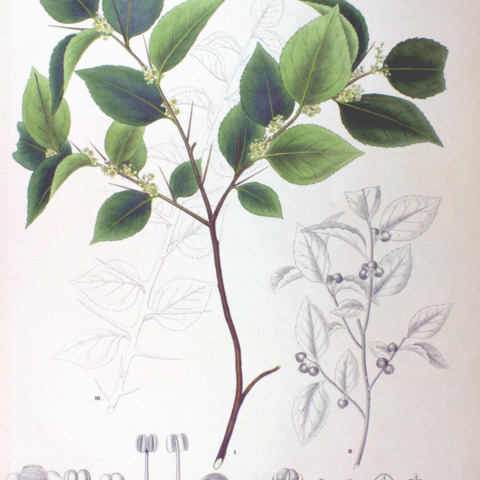Shrubs or small trees, evergreen, 4-15 m tall; bark brown-gray; branches spiny when young, unarmed when old, glabrous or puberulous. Stipules subulate, minute, ca. 0.3 mm, glabrous, in dried material dark brown or blackish, caducous or persistent for some time; petiole short, 2-5 mm, glabrous to quite densely pubescent with spreading hairs; leaf blade broadly ovate to ovate-elliptic, 3-8 × 2.5-3.5 cm, leathery, often glaucous below, both surfaces glabrous, or scarcely pubescent along veins below, lateral veins 3 or 4(or 5) pairs, base usually obtuse to rounded, less often acute, margin serrate, apex acute, tip usually acuminate, acumen 5-10 mm. Inflorescence axillary, racemose, short, 0.5-2 cm; rachis densely pubescent, hairs spreading, short; flowers yellowish. Pedicels very short, 1-3 mm in flower and fruit, pubescent. Bracts ovate to narrowly lanceolate, 1-2.5 mm, abaxially pubescent, ciliate, caducous or persistent. Sepals 4-6, broadly ovate with rounded apex, or orbicular, 1-2 mm, outside ± pubescent, inside glabrous, ciliate. Staminate flowers: stamen filaments long, eventually extending to ca. 3 mm; anthers ellipsoid, minute, ca. 0.2 mm, connective usually not projected beyond thecae; disk consisting of several, small, glabrous, closely set or connate glands. Pistillate flowers: disk annular, undulate; ovary ovoid, ca. 4.5 mm; placentas 2; styles 2, very short (to 0.5 mm) to nearly absent, joined in basal half. Berry dark red to black (black when dried), globose, 4-5 mm in diam.; calyx and disk persistent at least while fruit attached to plant; styles persistent. Seeds 2 or 3, reddish brown when dry, ovoid, flattened on one side by mutual pressure, 4-5 mm, completely covered in a thin membranous darkly streaked sheath. Fl. Jul-Nov, fr. Aug-Dec.
More
An evergreen tree. It grows 10 m high. It has sharp spines on the trunk. The leaves are oval and 3-8 cm long and 2-5 cm wide. They taper to the tip and are rounded at the base. There are teeth along the edge. The flowers are small and greenish-yellow. Male and female flowers are on separate trees. The flowers occur in groups in the axils of leaves. The fruit is like a berry and black. It is 3-4 mm across. There are 2-3 seeds.

